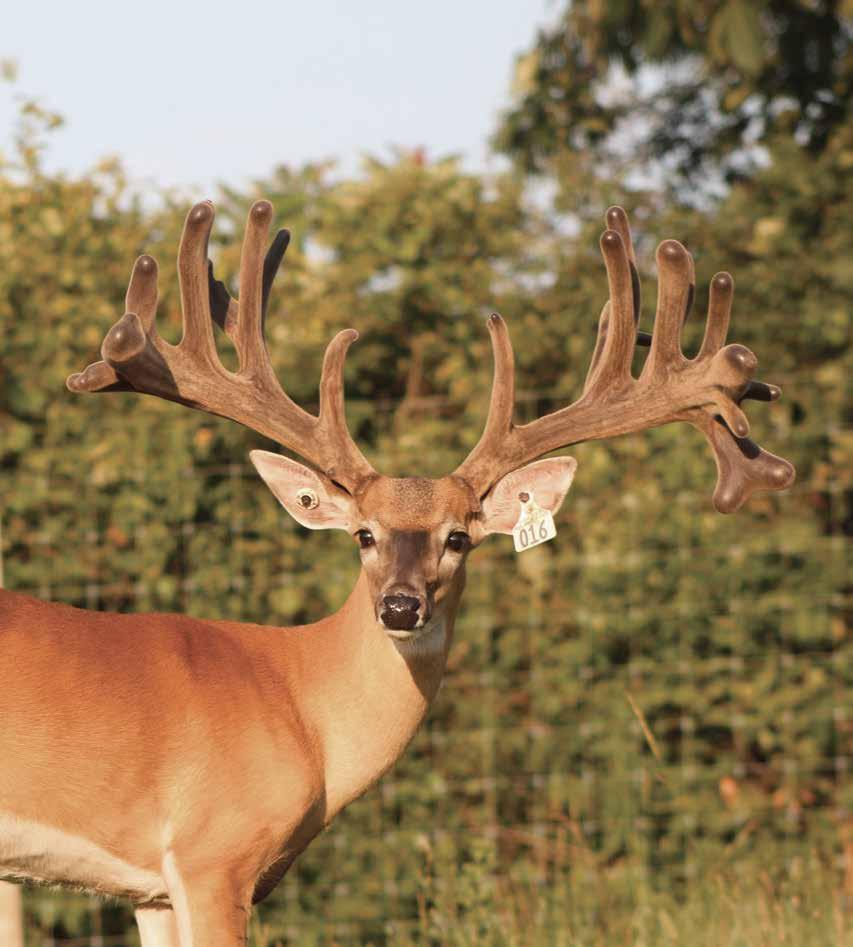
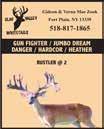

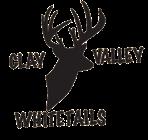
SUMMER 2022 l Volume 5 l Issue 2 See Ad Inside New York Deer and Elk Farmers Association NEW YORK GUNFIGHTER / JUMBO DREAM DANGER / HARDCORE / HEATHER Thank you Mountain Side Whitetails for selling us this amazing Buck! RUSTLER@2 SEE YOU AT THE PICNIC! AUGUST 20, 2022 FEATURE FARM STORY ANDERSON’S WHITETAIL RANCH CAPTIVE WHITE-TAILED DEER FAWN MORTALITY SECONDARY TO STRONGYLOIDES DR. TOBY PINN-WOODCOCK, DVM, DACVIM
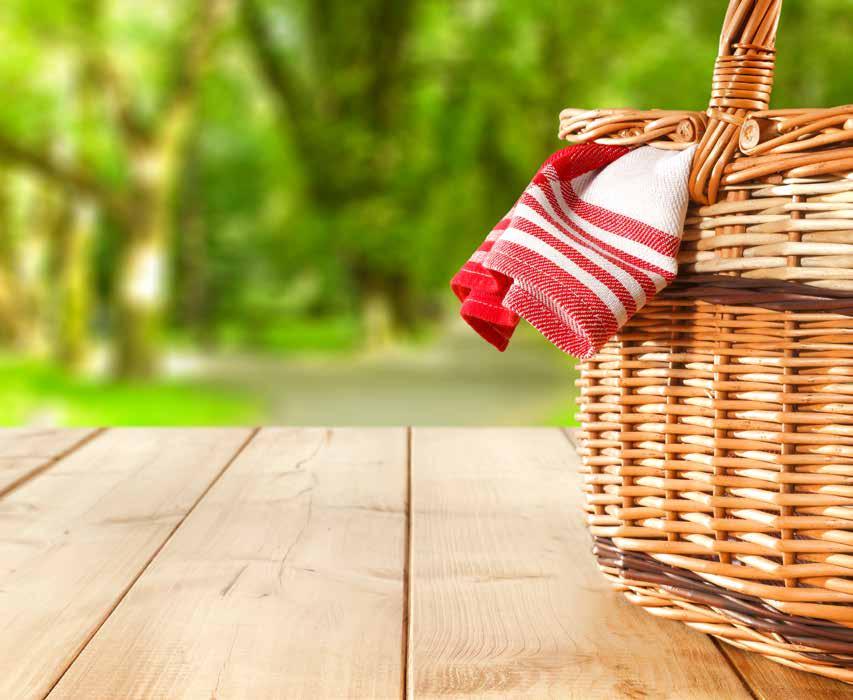
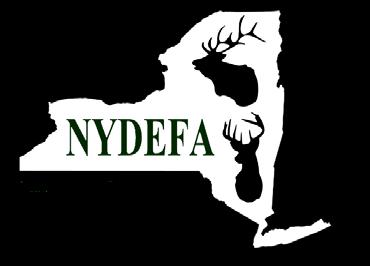
August 20th, 2022 Location: Prime Whitetails, Rush, NY (Mike Czora, 585-330-9100 • mike@primewhitetails.com) 9am • Saturday Bring mounts and antlers • Tables available to display Summer Picnic Lunch • Door Prizes Games • and more! For more information call or email: Dana Hoover, 315-595-2202 or email: dana@ibyfax.com
BOARD OF DIRECTORS
PRESIDENT
Dave Vanderzee
Easton View Outfitters
518-210-8889
eastonviewoutfittersllc@gmail.com
DIRECTORS
MIKE KERRY
Four Season Whitetails 315-783-2848
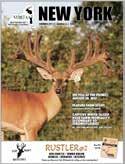
fourseasonwhitetails@hotmail.com
Robert Root
Moriah Elk Farm 607-657-8069
rootnyelk@aol.com
Tom Peryea 518-561-3555

tomselkranch@juno.com
TIM RATER
French Creek Whitetails 570 Maple Ave Clymer, NY 14724 716-355-8870
timrater21@gmail.com
MIKE ROSENWIE
Concord Whitetail Scents 12495 Kern Rd Springville, NY 14141 716-912-7314
rosey9473@hotmail.com
MIKE CZORA
Prime Whitetails 336 Woodruff Rd Rush, NY 14543
585-330-9100
mike@primewhitetails.com
WAYNE HETTENBAUGH
Valley View Whitetails NY 4496 RT 241
Randolph, NY 14772 716-499-9367
whett6@hotmail.com
DAN JENNINGS
JB Farms 143 Beach Hill Rd New Ashford, NY 01237 413-822-1040
dan.jennings02@gmail.com
1 NYDEFA 2022 ADVERTISERS INDEX 5 Star Genetics 20 Anderson’s Whitetail Ranch 10-11 Anglin Road ................................................. 8-9 Awesome Whitetails 34 Blessed Bayou Wildlife & Fisheries Consulting................................ 12 C&E Wildlife Products 2 Cervid Solutions, LLC 25 Clay Valley Whitetails ....................... Cover, 3 Cuddlies 34 Dan-Inject North America 21 Ezid LLC 29 Fox Valley Animal Nutrition, Inc 15 Head Gear LLC 17 Hilty Whitetails ............................................. 22 Illini Whitetails In. B. Cover Mountain Side Whitetails B. Cover NexGen Compounding 7 Pine Creek Deer Farm 33 Pneu-Dart, Inc 23 Prime Acres 16 Purina 19 Rocky Ridge Whitetails 14 Sunrise Supply, LLC 29 Trophy Whitetail Deer ................................. 5 Woodard Whitetails 26 IN EACH ISSUE Advertising Information 27 Business Card Advertising .............................13 Letter from the Editor ...................................... 4 Members Message 2 Membership Application 30
CONTENTS FEATURED ARTICLES: Controlling Parasites in Humid Climates - Helpful Tips and Advice .......................................................... 35 Fawn Mortality associated with Strongyloides 24 NADeFA Thanks Senators for Introduction of Legislation to Combat CWD ............................................... 36 NYDEFA Picnic ................................................ Inside Front Cover Protecting Fawns from Predators 6 The Art of Antler Trimming 18 The Benefits of Using Deer Tunnels ...................................... 32 FEATURE FARM - Anderson’s Whitetail Ranch ..... 10-11 MAGAZINE GRAPHIC DESIGN AND PUBLISHING: D & K Design 305 E. 350 N., Ivins, UT 84738 deerassociations@gmail.com P) 435-817-0150 (Editorial Provided by Contributing Writers) MARK YOUR CALENDARS! FALL MAGAZINE DEADLINE Oct. 14
NYDEFA MEMBER MESSAGE:
NEW YORK DEER FARMERS SHARING EXCITING TIMES
Isincerely hope everyone had a great and prosperous fawning season this year. As fawns grow up, bucks are growing out, and you can start to see the fruits of your labor. This makes deer farming very rewarding. After successfully utilizing embryo transfer technology for the last three breeding seasons at my farm, I have new and exciting pedigrees in my herd and feel encouraged about the future. Our upcoming A.I. season could be the best one yet!
Because New York is one of the greatest places for deer farming, our state always seems to welcome new farmers each year. Last year, Clay Valley Whitetails farm was started by Gideon Zook.
I’d like to congratulate him on his new venture and decision to purchase the front cover of this magazine, featuring a picture of a two-year-old buck purchased from my farm. I hope this new buck with his well-bred genetics serve him well and helps him achieve the success all of us know and enjoy.
In addition to welcoming new deer farmers, we also have our annual picnic August 20th to look forward to at Mike Czora’s place, Prime Whitetails. Mike and Sandy always do a fantastic job making this event one of the highlights of the year. Mark your calendars for not only that, but also for the August 26th Pennsylvania Deer Farmers Association Fall
Stocker Buck and Breeder Buck Sale in Altoona, Pennsylvania at the Blair County Convention Center. Although we can’t bring deer from Pennsylvania to New York, it is a great place to socialize with other deer farmers.
In closing, I want to thank all New York deer farmers for their continued support and enthusiasm for our association. We appreciate you and look forward to seeing you soon!
Dana Hoover, Owner of Mountain Side Whitetails

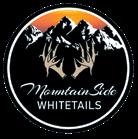
2 NYDEFA 2022
NYDEFA Member
GUNFIGHTER / JUMBO DREAM
DANGER / HARDCORE / HEATHER

3 NYDEFA 2022
Letter from the Editor, Kathy Giesen




even more important is the enthusiasm felt from renewing members and the anticipation of learning more about other state associations felt by newly registered members.
My Multi-State Association Booth has become a mainstay at many state association events, created to entice industry participants to not only support their own state association, but to join others as well. Making this a one-step and easy process has always been my goal as individuals can fill out one simple form and make one payment, and yet join as many associations as they wish. And each year at NADeFA conventions, anyone who joins multiple state deer associations is entered into a drawing for a special high-end gift.
In 2019, Brandon Walker, Manager of Cedar Breaks Ranch in Midland, South Dakota won a camouflaged, weatherproof and easily assembled deer blind.
Viola, Kansas won the drawning with his participation renewing memberships with three state associations. The prize this year was a Holy Stone GPS Drone. Many conference attendees checked back with me afterwards in the hope that they had won. But don’t dismay. We may have another drone in the near future to offer. Right now, Brad is really enjoying his new and well-deserved gift.
I greatly appreciate everyone who offers their support in the form of advertising, as this provides revenue to publish each magazine and helps alleviate the obligation from state associations for this purpose. Advertising is the best and most effective way to keep your farm, product or services in front of those who need it most. While advertising has been proven to work well when done consistently and repetitiously, some advertisers such as Mary Volk of Cuddliez custom embroidery service,
If you have a story to share, pictures that you would like to show off, or would like to participate in one of our advertising programs, please give us a call!


in these popular e-books, as well as for updated features on our multi state association website, deersites. com. As 2022 progresses, please know that I am proud to be a part of such a great and inclusive industry. If anyone is interested in pursuing a Feature Farm article with my journalist Gail Veley, please get with me on pricing and other details. And remember to officially start marking your calendars for March. It’s our new official “Membership Drive Season!!”
Kathy Giesen, Editor / Publisher, D&K Design 435-817-0150
deerassociations@gmail.com

Event
Ad Deadlines Visit: deersites.com
Advertising Forms
Dates
2022 Multi State Membership Winner Brad Farmer




PROTECTING FAWNS FROM PREDATORS
By: NexGen Pharmaceuticals
For the deer farmer (or the rural property owner who just wants to give deer herds a fighting chance), mitigating the predation of fawns to the greatest degree possible is an ongoing concern. Given the ongoing concern and intervention of wildlife biologists, starvation and disease are seldom the concerns they were in years past, which leaves predation as the most prevalent cause of fawn mortality. This is particularly true in the case of whitetail deer, which live in close proximity to humans in large numbers, even when we don’t consider farming operations. Here, we’ll look at a few key areas that deer farmers and property owners can effectively address to reduce the predation of deer fawns, as well as supporting herd health overall.
Predator control. Protecting fawns is obviously crucial to herd development. While bobcats, bears, eagles and feral dogs do kill their share of fawns, this is usually not in sufficient numbers to have a substantial impact on herds. Thus, most control efforts are directed toward coyotes which, statistically-speaking, are the leading cause of fawn mortality.
Most sportsmen and deer farmers agree that a healthy population of predators is good for ecosystems however, opportunistic coyote packs picking off fawns on a farm is far less than ideal. Like deer and other game animals, predators also need managing.

Those with experience in these areas agree that the most effective way to control predators is to hunt or trap them. Unfortunately, killing coyotes outright doesn’t do much to significantly reduce their numbers over the longterm, and they can be difficult to hunt— so keeping on top of them is an ongoing proposition.
Herd management. Managing herd sizes and ratios of sex and age are also essential components to ensuring the survival of more fawns. A high population density can lead to stress on all of the animals in a herd, and it disrupts their natural behavior. Keeping sex ratios balanced and ensuring that the carrying capacity of the land can support all of the deer is essential. This may mean relocating or removing a certain number of does periodically. The available research suggests that mature does produce more fawns; thus, removing younger does is more likely to improve fawn survival within a herd.
Habitat management and cover. Most of the evidence suggests that farmers and landowners who’ve been successful at reducing fawn mortality have taken a cue from wildlife biologists and wildlife managers. In order to reduce predation, one of the chief areas these experts advocate keeping on top of is that of habitat management. One of the ways this can be accomplished is by exploiting the natural behavior of deer (specifically, does and fawns) and managing your property in ways that enhance a fawn’s chances for survival organically.
The available literature maintains that providing cover is the single most important factor in reducing the predation of fawns. One thing to remember is that does and their fawns naturally seek cover. Whitetail deer in particular prefer the ecotone (forest

fringe). This is partly because these areas receive more sunlight, which promotes the growth of vegetation. More importantly, this zone typically provides more cover than open areas, but doesn’t have the predator density of the deep forest. One study revealed that fawns in areas with the little edge habitat were more than twice as likely to be eaten by a coyote than those in areas with more edge availability.1 Does have evolved to be protective of their fawns, and will seek out safe areas for them to rest. Providing places on your property/farm that are attractive in this regard can improve the odds for fawns. Cutting down small trees and placing brush areas for does to hide their fawns is a great idea. These will resembled the natural deadfall that does are accustomed to using for this purpose. Creating spaces like these will help to better protect them from predator animals in the area.
As mentioned earlier, we’ve learned a lot from the wildlife biologists who’ve dedicated many years toward refining the population management of deer— and among what we’ve learned is that responsible predator management supports both ecosystems and deer populations. Obviously, predator management is even more critical when we’re talking about deer farming. Wherever you happen to live, and whatever your predator problems are, addressing the three basic areas we’ve discussed will go a long way toward reducing the predation of deer fawns, as well as reducing overall fawn mortality and supporting a healthy herd.
6 NYDEFA 2022
1Gulsby, W. D., J. C. Kilgo, M. Vukovich, and J. A. Martin. 2017. Landscape heterogeneity reduces coyote predation on white-tailed deer fawns. Journal of Wildlife Management 81:601-609.
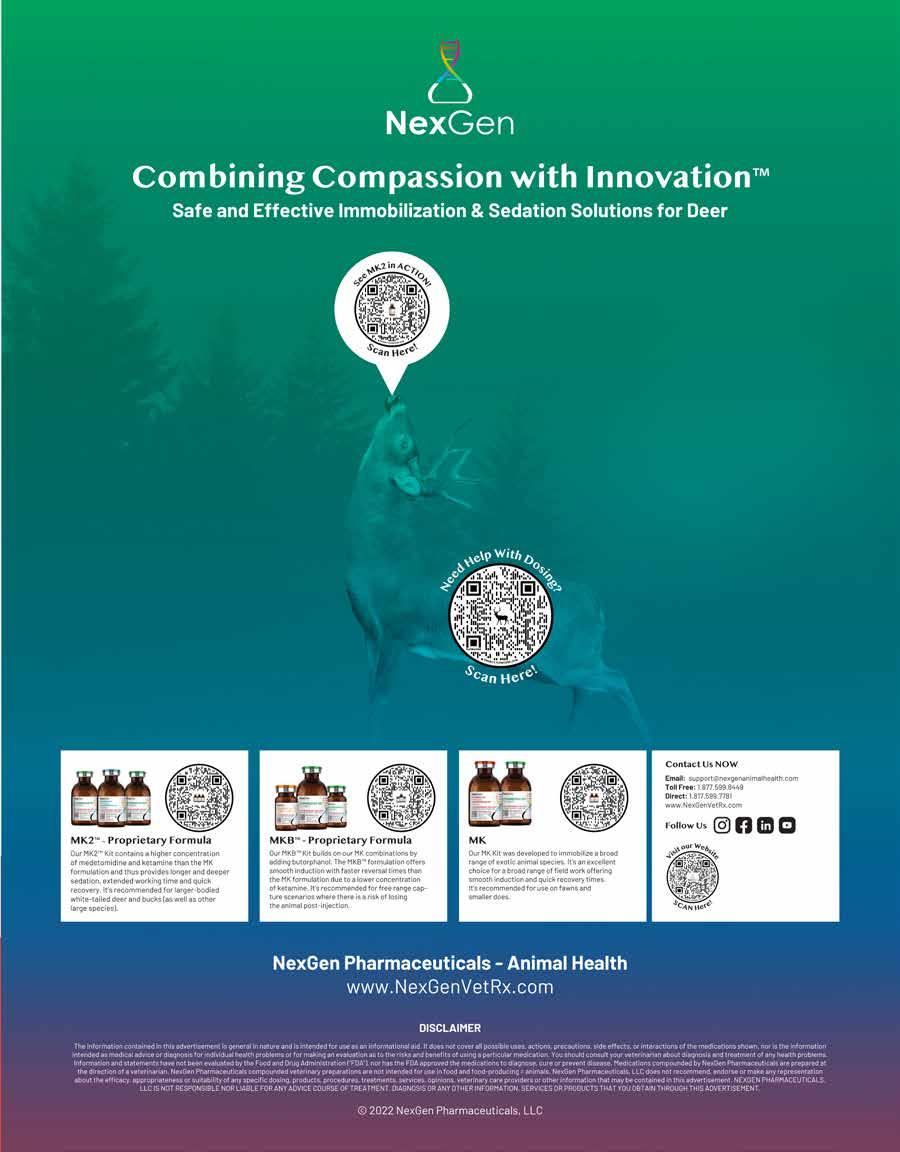
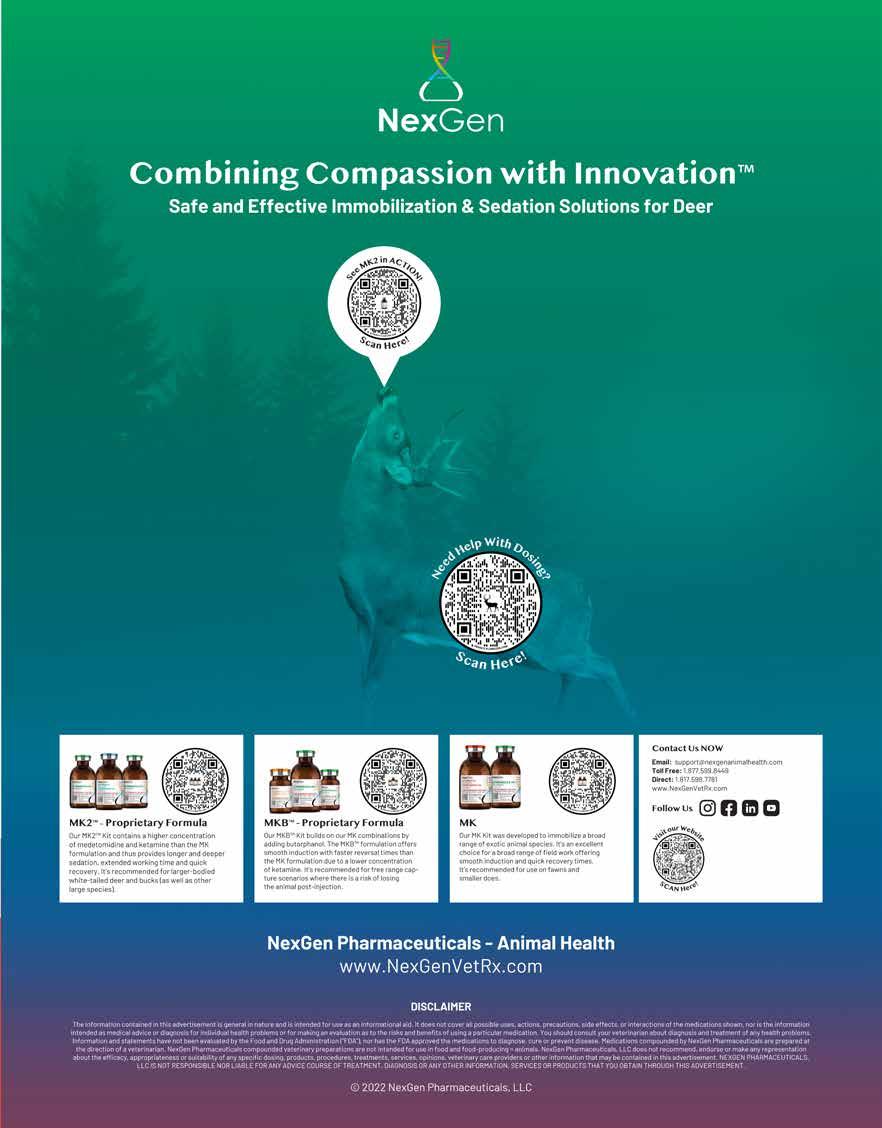
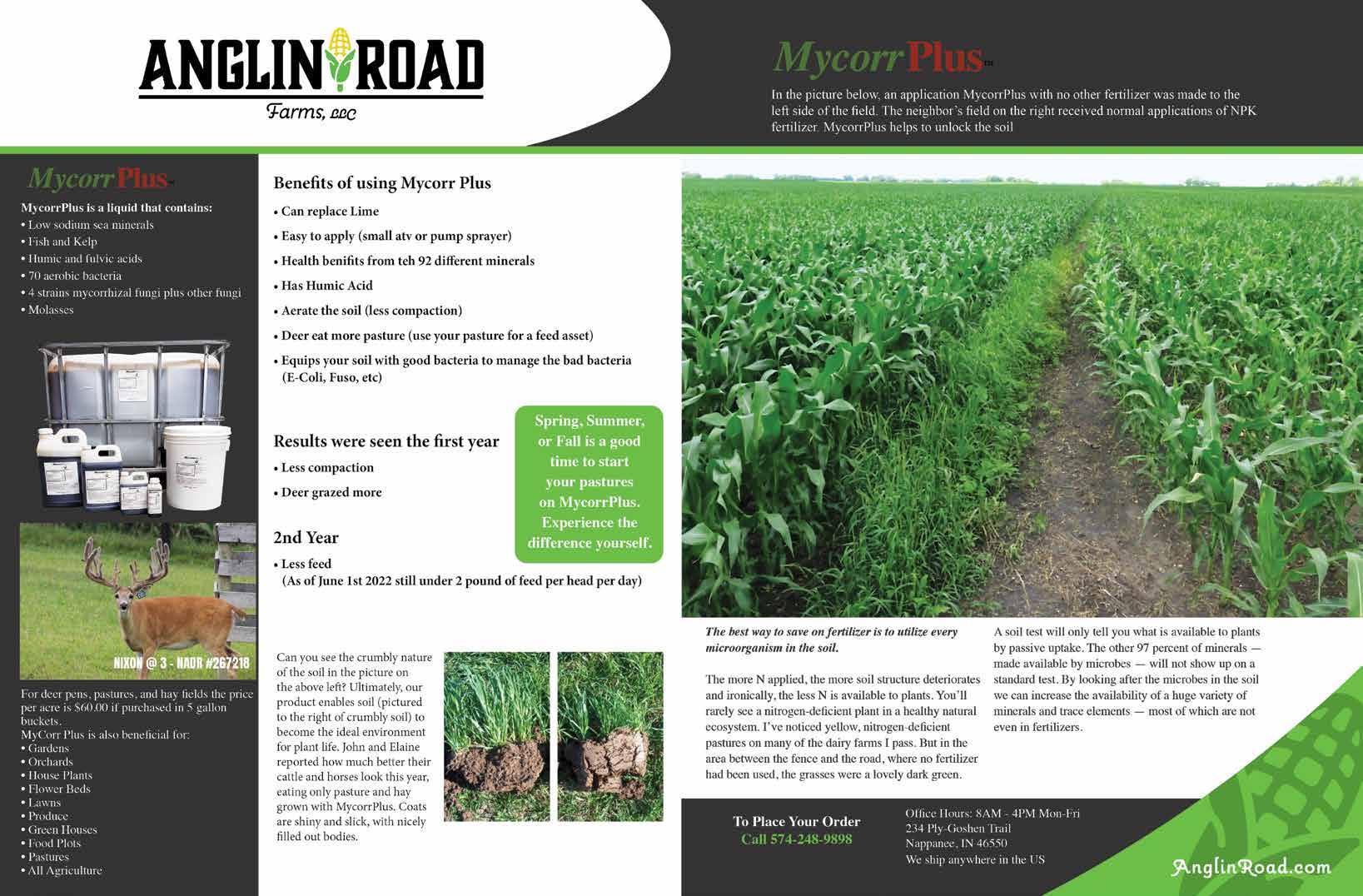

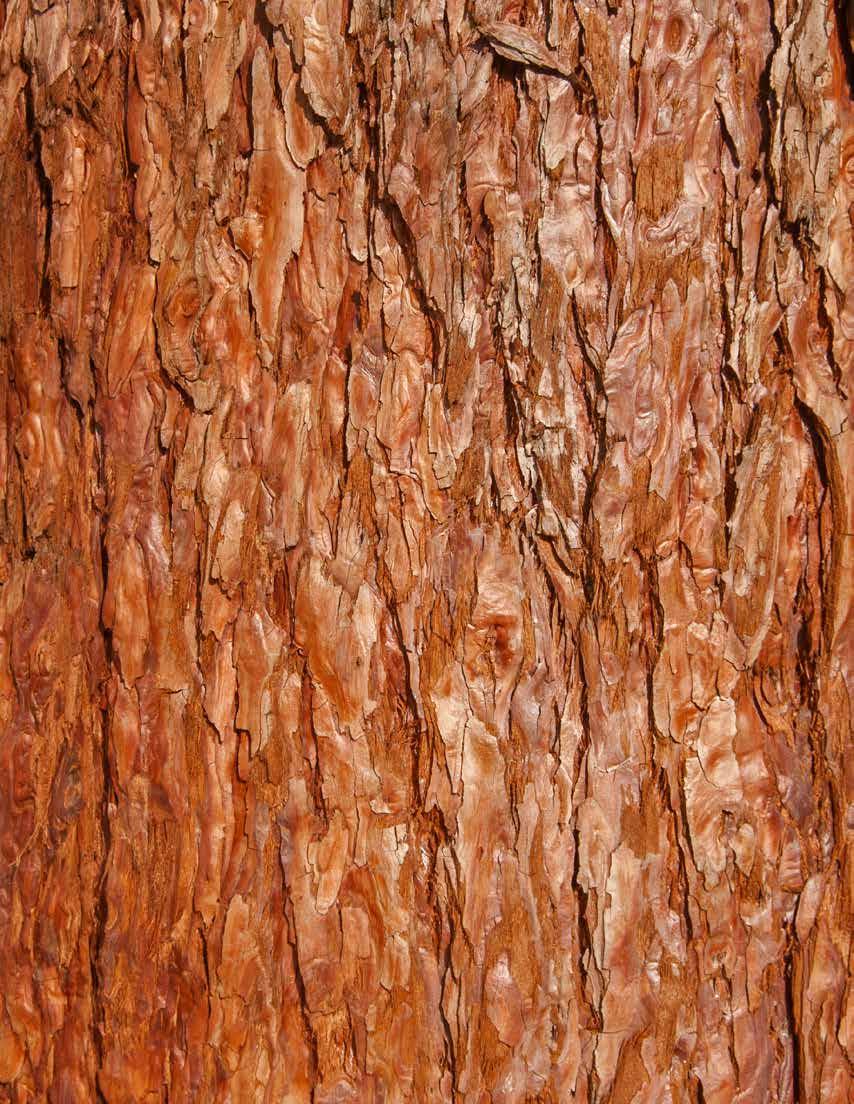
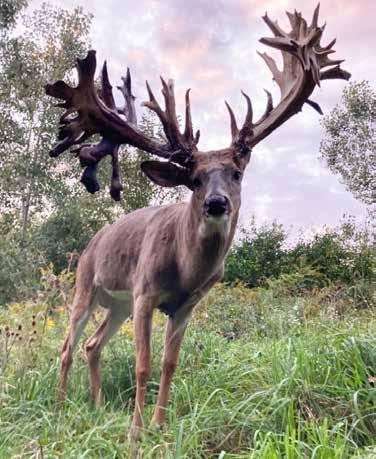
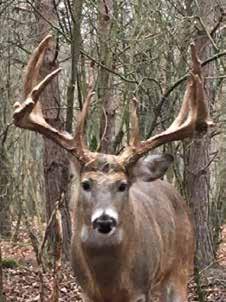
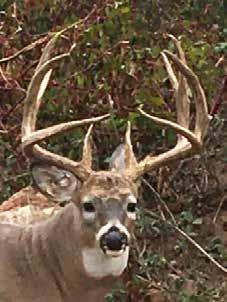
Redwood @ 4 Always produced 180”-215” Typical 2 year olds Typical 2 year olds Bill Anderson 2249 Kendall Road, Kendall NY 14476 Emaill: whitetailschool@yahoo.com Anderson’s Whitetail Ranch Mountin’ Man Taxidermy 36 years full time taxidermist Whitetailtaxidermyschool.com Phone (585) 269-9933
ANDERSON’S WHITETAIL RANCH PROUD TO RAISE DEER IN BEAUTIFUL, UPSTATE NEW YORK
By: Gail Veley
Bill Anderson noticed right away in the spring of 2019 that something wasn’t quite right with a newborn doe fawn. Rather than bending normally, it’s back legs were stiff and straight from contracted tendons making it unable to stand and walk. Compassion for this fragile new life quickly turned into action as Anderson put popsicle sticks and vet wrap on each hind leg for support. Luckily for him, the mother doe was tame enough to allow Anderson to nurse the fawn from her for the colostrum. After that the tiny fawn became a “house deer” and was regularly bottle fed. At night, Anderson would sit on his couch and repetitiously bend each leg to stretch the tendons. Instinctively, his beagle Lila decided to help and literally take over as “Mom.” Licking and guarding “her” fawn day and night, she growled anytime another family dog got too close for comfort. Together, Anderson and Lila nurtured the fawn back to wholeness. Last spring, this special doe had twins.
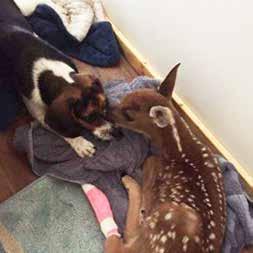
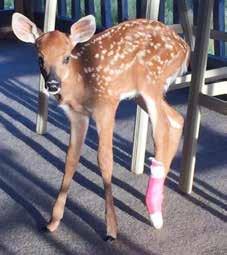
While Anderson, 60, enjoys raising whitetails as a business at his 109acre paradise, Anderson’s Whitetail Ranch in Kendall, New York, his love, obsession and soft spot for deer is obvious. It first began when as a
10-year-old boy, Anderson found a deer skull and horns in the woods. At age 13 he started hunting with his late father, Ed, with whom he started a taxidermy business in 1986. Eight years ago, he purchased three tame deer from the late Dave Gustke (mainly to provide live subjects for teaching classes on taxidermy which had started in 2010) and soon realized he had the fortitude and ambition to raise deer and become more deeply entrenched in the industry. To that end, he officially started his deer farm, raising both typical and non-typical deer while acquiring genetics from the likes of X Factor, Dream Rolex, Jumbo, Sweetwater, Boo Boo, Shadow and Highroller among others. Last year, he sold deer to two new farms in addition to providing guidance to them for getting started.
Currently close to 100 deer thrive at Anderson’s Whitetail Ranch, where every breeding doe is named after a flower such as “Lilly” and every breeding buck is named after a tree such as “Willow.” His most prized breeding buck, “Redwood,” who scored 366” last fall, is actually an impressive non-typical buck out of Jumbo, Jumboton, Texas Tea and Blue Mountain Bill. Bought four years ago from fellow deer farmer Mike
Czora, “everything out of Redwood is typical,” said Anderson, who thoughtfully selects does out of typicals to breed him to. “One of his son’s was a 179” typical eight-pointer at two years old.”
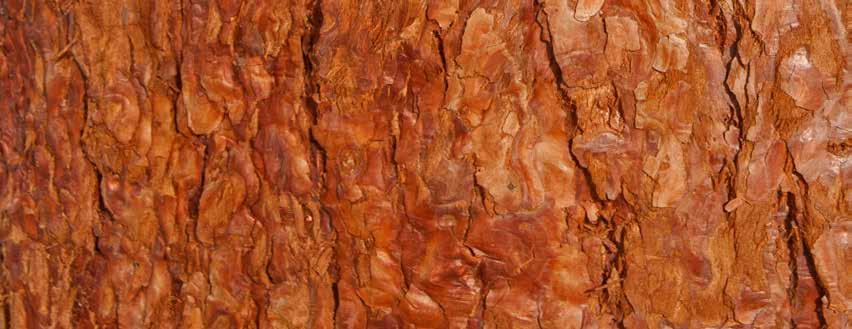
While raising quality whitetails and providing excellent animal husbandry is a priority to Anderson, he offers some of the credit for their vitality to the environment in which his deer are raised which includes open pastures, northern hardwood trees, former apple orchards, swamps and natural ponds. Perhaps as a by-product of living in a more natural setting, his bucks have darker, more deep brown antlers.
Helping to run the farm is Anderson’s son, Wyatt, and his nephew, Alex and his fiancé Alina who is in vet school. He is very grateful for their help and for the mentoring he received along the way from Czora and his girlfriend, Sandy as well as Wayne Hattenbaugh. If Anderson were to offer his own mentoring and advice to future deer farmers, it might be this. “Don’t name all of your deer, and don’t bottle feed them” he said. “It makes them too hard to sell. We used to name our deer. Now we use numbers. And remember, you will have good and bad days. In the end, it’s worth it. The deer industry is full of great people, no one is competitive, and they are always willing to help each other out.”
Anderson’s Whitetail Ranch Phone (585) 269-9933
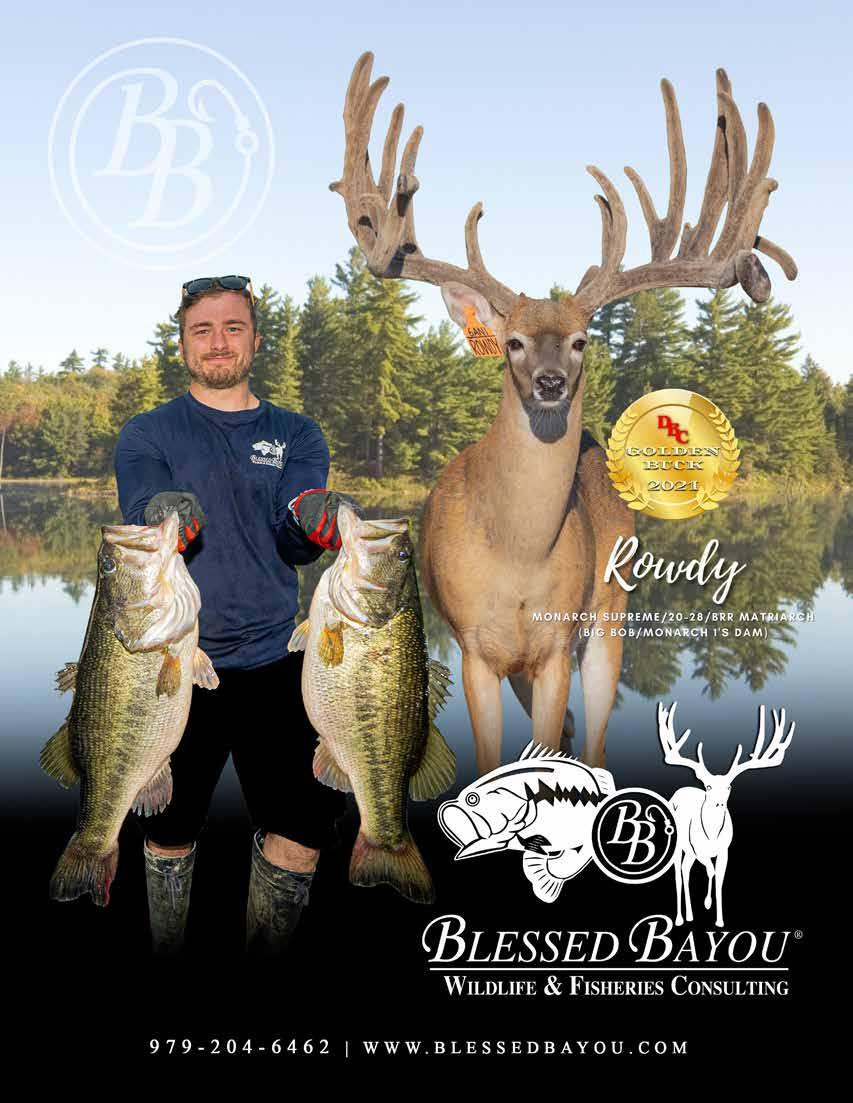
FREE business card ads for members of New York Deer and Elk Farmers Association
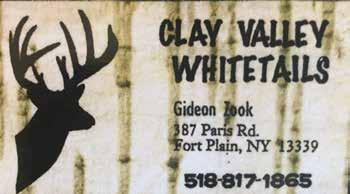

If you would like your farm or business featured on our business card pages, email digital pdf file or scanned image (must be readable resolution) of your business card to the email address below.

This gives NYDEFA members a way to reach out to one another for services and to buy or sell deer! There will be limited pages for these card spreads, first come first serve. The overflow would be placed in the next issue and cards will be rotated each quarter. Email to: dana@ibyfax.com or call Dana at: 315-595-2202
Hoover 4456 Champlin Rd. Penn Yan, NY 14527
P 315.595.2202
F 315.595.8863

dana@ibyfax.com

13 NYDEFA 2022
Dana & Ella
Raising Quality Whitetails Bucks, Does, & Fawns For Sale
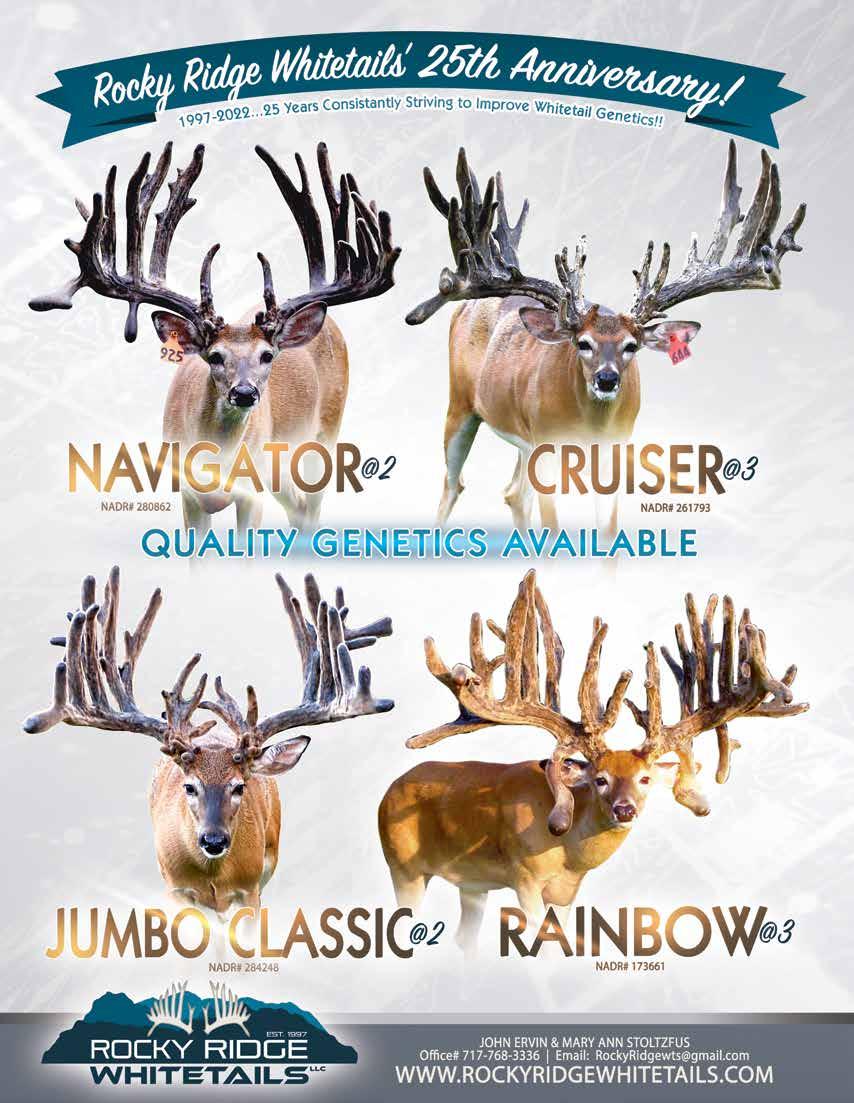

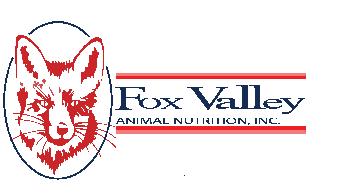






15 NYDEFA 2022 • All-Milk Protein from Premium Food-Grade Milk Ingredients • Essential Vitamins and Complex Minerals • Balanced Fatty Acids • Improves Digestion • Promotes Growth and Performance • No Refrigeration Needed • Easily Palatable Nick Vlamis , President Email: nklc@aol.com www.foxvalleynutrition.com DAY ONE FORMULA Species - Specific for Whitetail, Mule Deer & Elk “Better Than Mother’s Milk” DON'T LOSE A FAWN THIS YEAR TO POOR NUTRITION (847) 687-3200 (800) 679-4666 • 18 Month Shelf Life • Available in 20# & 8# pails • 24/7 Technical Advice & Support

G FORC E™
Science that delivers the health & productivity you require
P
SCIENTIFICALLY FORMULATED NATURAL SUPPLEMENT
TO HELP GROW LARGE, HEALTHY DEER AND BIG ANTLERS!
Nutrient rich formula contains highly bioavailable ingredients, including our proprietary calcium/phosphorous complex with Antler D TM, that are required to support body and bone growth, especially for fast growing bucks
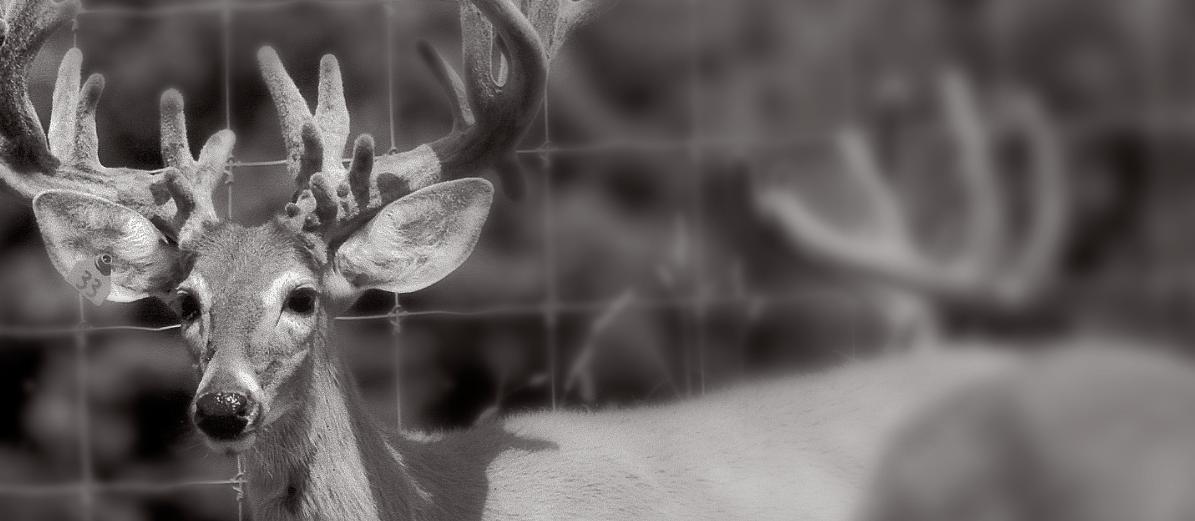
Contains probiotics and targeted enzymes to support gut health and proper digestion
Available in pellet or powder that can be top dressed or mixed in feed. Great for antler growing season and young bucks, too
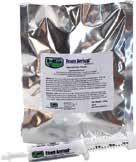
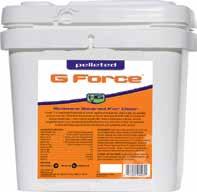
eaceMaker™
PRECISELY FORMULATED TO HELP MAINTAIN A NORMAL AND RELAXED DISPOSITION IN ALL CERVIDS
Provides optimal levels of magnesium, Vitamin B1 and inositol to promote calmness and provide help for restless animals
Contains no herbals, tryptophan or chemicals, eliminating concerns of unwanted side effects
Use PeaceMaker to “keep the peace” during pre-rut, rut, transportation, weaning and anytime destructive behavior may occur
ENTERIC HEALTH FORMULA
POWERFUL SOLUTION FOR HEALTH & PRODUCTIVITY

Helps maintain digestive health and productivity
Contains micro-encapsulated probiotics, targeted enzymes and a novel fiber complex
Use in does before fawning, during lactation and all cervids during times of environmental stress

FAWN ARRIVAL™ POWDER & PASTE
HELPS PRODUCE HEALTHY, FAST GROWING FAWNS
Helps maintain normal digestive health
Supports a healthy immune system
Feed powder for 14 days to bottle fed fawns
Paste is ideal for fawns left on does

FAWN & DEER XTR™
ROBUST FAST RESPONSE FOR FAWNS & OLDER DEER
Innovative formula delivers max digestive support, especially in newborns
Rapidly delivers help for GI health and a functioning immune system
May also be used post-tranquilization to support healthy recovery
17 NYDEFA 2022
Science Geared For Deer H ead G ear LL c 1383 arcadia road , suite 102 / L ancaster , pa 17601 p H one 717-509-5724 www H ead G ear LL c com scan to L earn more
THE ART OF ANTLER TRIMMING
By: Gail Veley - Sponsored by Whitetails of Louisiana (WOL)
Having everything you possibly think you might need makes the job of trimming antlers infinitely easier and more efficient, explains Kris Rothchild of All In Whitetails deer farm in Eros, Louisiana. Safety is the Number One reason any deer farmer makes the decision to trim antlers, as the rut season approaches. While any buck may look impressive sporting 500-inch antlers, “we don’t need him with 500 inches of antlers hurting us,” Rothchild emphasized. “We cut antlers because another we don’t want a deer getting gored or a person getting injured,” she added.
Whether it’s a scheduled hard antler trim in late fall or a trim while in velvet due to injury or infection, all scenarios require extreme preparedness, Rothchild said. In addition to her job as a registered nurse, Rothchild, 44, has assisted veterinarians such as Dr. Lauren Harper in trimming antlers on various deer farms in Louisiana. Because of her medical knowledge and experience, Rothchild offers the following advice for optimum safety as well as efficiency:
1. Have someone else there to assist you and ensure your safety. Never handle deer alone.
2. Never plan on antler cutting to be a real “quick fix.” Always be prepared to take your time.
3. Make sure all of your tools are operational, well-maintained and inspected before use.
4. Have a large bucket of ice water, two bath towels and alcohol and help
keep the temperature of the deer within the minimum range during the entire process. Never trim antlers on a day above 78 degrees.
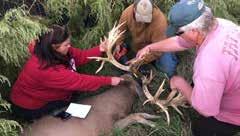
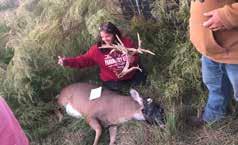
5. Determine beforehand how long the deer may be down and choose the proper sedation medication (such as BAM for shorter periods or a combination of medetomidine and ketamine “MK” for longer periods).
6. Ensure you have the proper amount of CO2 for your dart guns, the proper darts and any medications you plan on using such as antibiotics. In addition, make sure all of your vaccines are ready to go.
7. Never enter a pen without a good saw with a fresh blade. Always have a backup blade as well. (Josh Kaplan of Golden Ranch Whitetails in Gheens, Louisiana prefers to use a reciprocating saw with a steel blade as he feels it can cut through anything very fast.)
8. Should cauterizing of blood vessels be necessary, use a hot blade or searing knife and banding system to act as a tourniquet to stop bleeding. This might be safer and more sterile than inserting objects such as toothpicks into the blood vessel to stop bleeding and may also reduce the possibility of infection. However, Kaplan feels toothpicks work tremendously well and has never had an issue or infection as a result of using them.
9. Never trim too close to the pedicle (located at the base of the skull) where antlers grow from, as this can cause irreparable damage and perhaps cause antlers to not grow again.
Should a deer farmer be facing a situation where antlers could jeopardize the health or safety of a herd, “I would not risk the life of one of my prized bucks to save an antler,” Kris explained. “Realize he produces more for your farm than what he grows on his head. That’s a wise rule to live by with your deer.” Kaplan agrees and echoes her sentiments. “If you have any thought there is an antler infection they have to come off. You will always be better off acting quickly and not having future problems or issues,” he said.
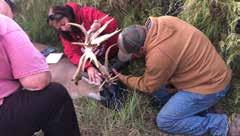
18 NYDEFA 2022
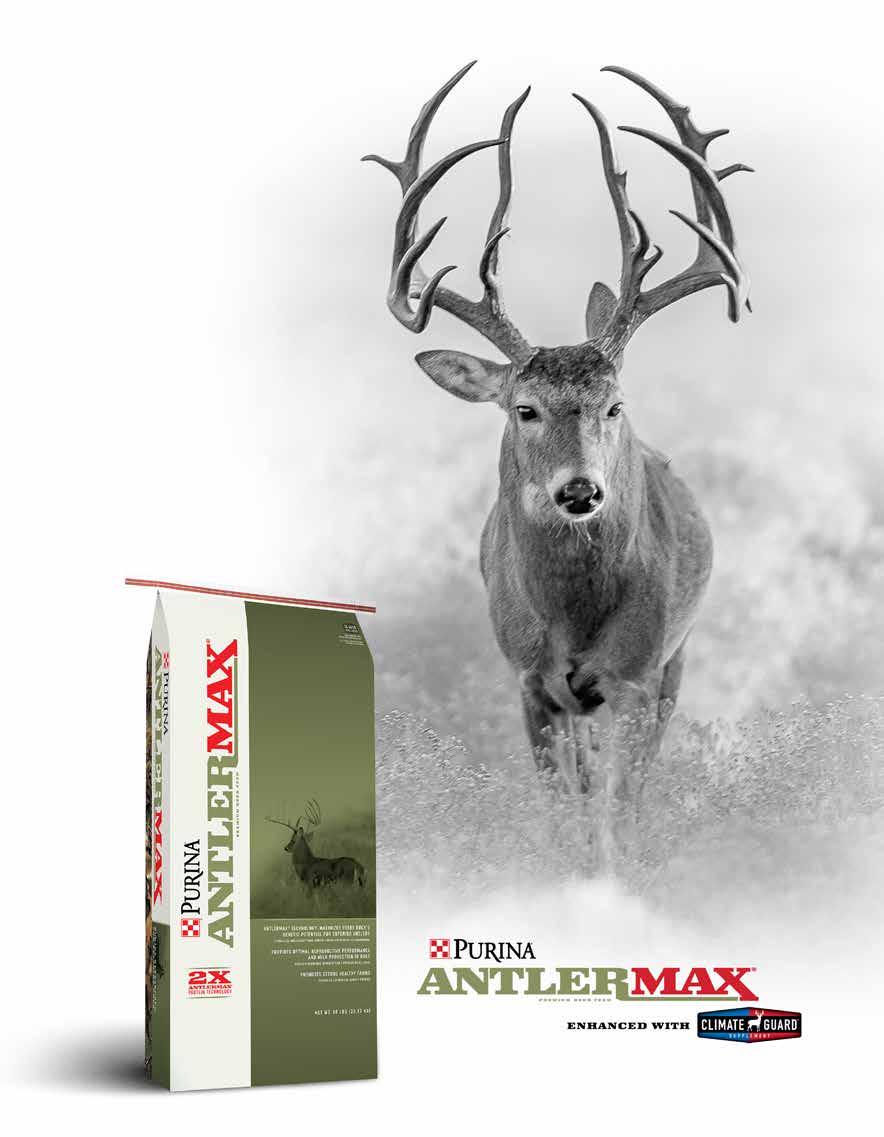

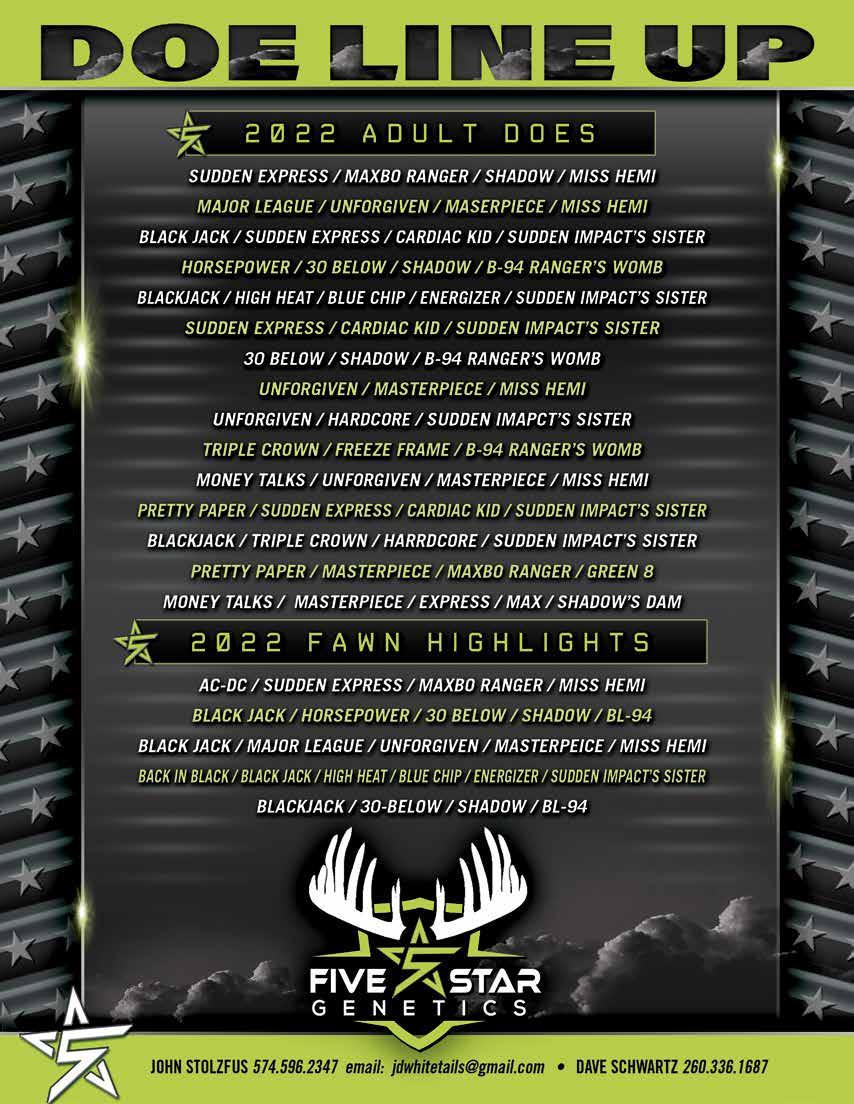
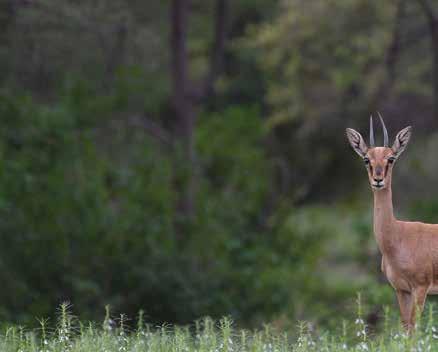
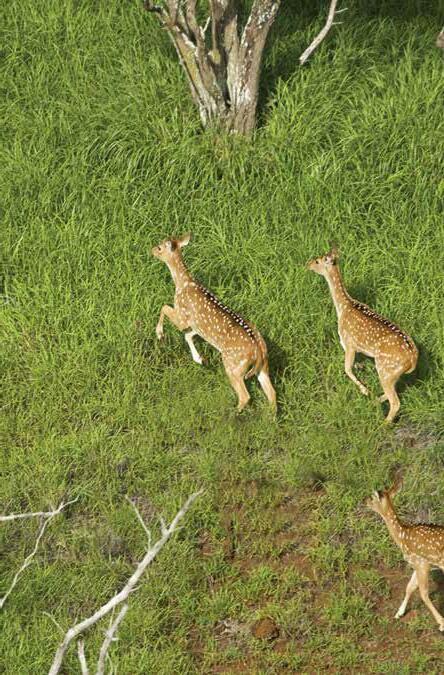
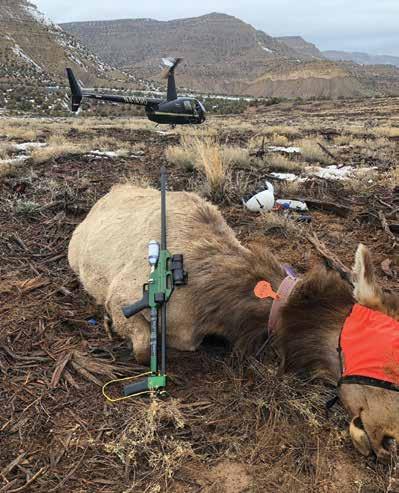
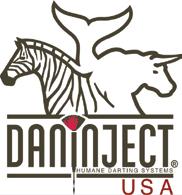




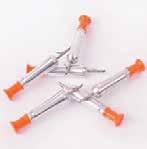










21 NYDEFA 2022 WildlifeCompanyGroup.com Let our 20+ years of experience in the field be yours 512-920-4757 orders@WildlifeCaptureEquipment.com 979-203-6735 info@DanInjectDartGuns.com HOODS AND MASKS NET GUNS & NETS DISPOSABLE DARTS CARRY RUGS C02 DART GUNS Use as close as 1 yard! Lightweight! Virtually Silent! Low Maintenance BLOWPIPES Made of Aluminum Won’t Bend or Break! JAB STICKS Fully Automatic. Liquid Releases within 1-1.5 seconds! PISTOLS Great For Short Range Shots! Side-Ported Needles Re-Usable!
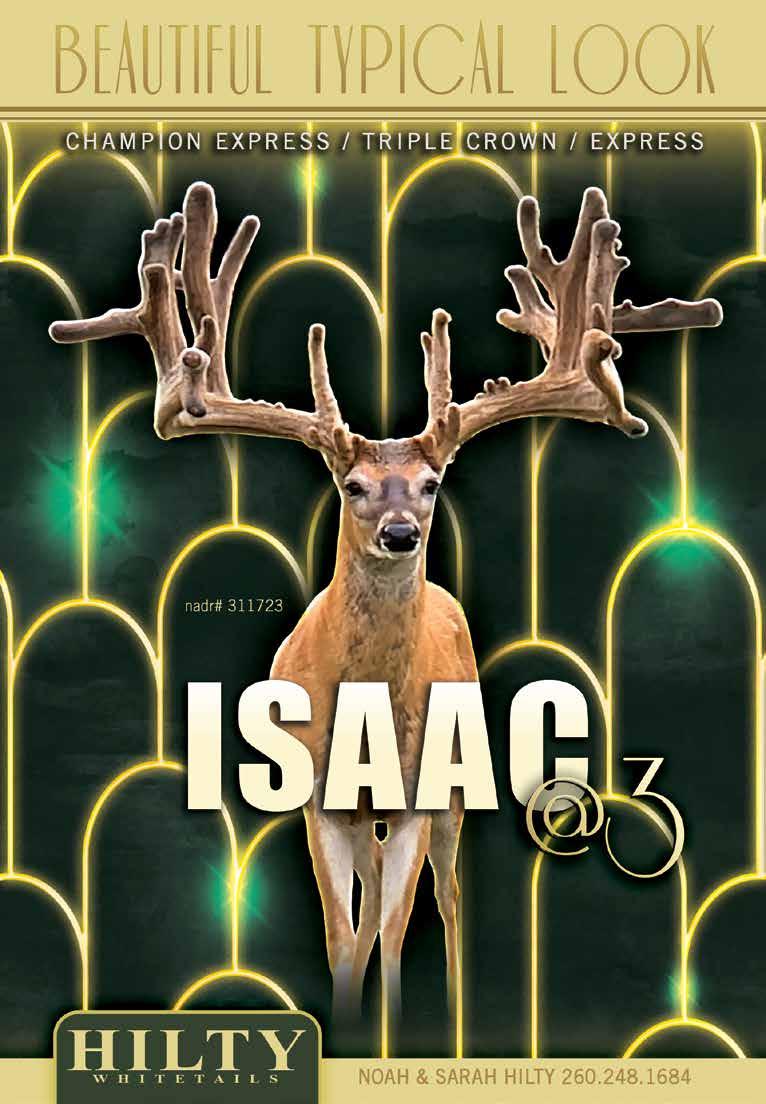
OUR RDDS ARE RIGHT ON TARGET





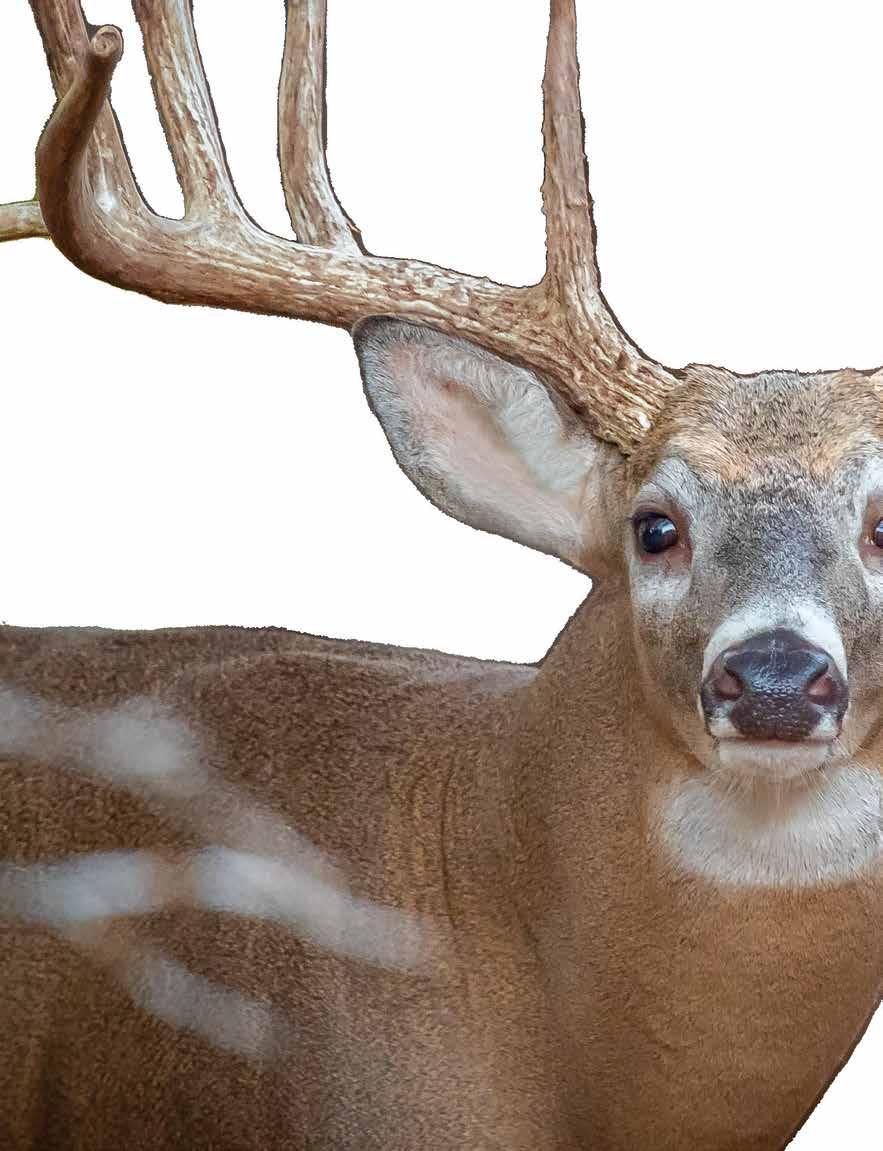
THANKS TO OUR PATENTED SLO-INJECT® TECHNOLOGY

Our disposable RDDs are shorter in length and the lightest on the market thereby providing the ultimate accuracy while reducing the potential for problematic hematomas. Our Slo‑Inject® technology means that your medicine is delivered in the most effective manner possible.








Pneu-Dart. Always right on target.





PneuDart.com > 866.299.DART CELEB R ATING OFSE RVICE
Photo credit: Dan Verrips
Captive White-Tailed Deer Fawn Mortality Secondary to Strongyloides sp. infection in New York State
Author: Dr. Toby Pinn-Woodcock, DVM, DACVIM Assistant Clinical Professor Veterinary Support Services, Cornell Animal Health Diagnostic Center Large Animal Internal Medicine Clinician, Cornell University, College of Veterinary Medicine
Strongyloides sp. has been identified as a cause of high fawn mortality in several New York state captive whitetailed deer (WTD) herds during the last 4 years. Fawns from these herds submitted to the Cornell Animal Health Diagnostic Center (AHDC) had histories of acute onset of decreased appetite, dull/lethargic attitude, weakness, and sometimes diarrhea at approximately 8-21 days of age. While a subset of these fawns had diarrhea prior to death, it was not a consistent clinical sign. Producers reported rapid deterioration and death of these fawns within 12-24 hours of the onset of clinical signs, despite supportive care with antimicrobials, antiinflammatories, oral feeding and IV fluid therapy. Fawn mortality rates of greater than 50% were reported in affected herds. Post-mortem examinations revealed parasitic enteropathy with coiled nematodes within the proximal duodenum and high numbers of Strongyloides sp. eggs identified in feces or colon contents. Concurrent bronchopneumonia was also described post mortem in some cases. PCR analysis of adult female worms from one affected herd identified Strongyloides vituli. This species has also been identified in adult wildlife
WTD submissions suffering from weakness and weight loss. Ancillary diagnostic testing performed to rule out other differentials in these fawns were negative, including diagnostics for Salmonella sp., rotavirus, beta coronavirus, pathogenic E. coli and bovine viral diarrhea virus.
Strongyloides papillosus infection has been previously described by Forrester et al. in 1974 as a cause of high fawn mortality in one captive WTD herd in Florida. Age of onset, clinical

signs and post-mortem findings were similar to those described in NY herds where S. vituli has been diagnosed. Strongyloides papillosus and S. vituli are morphologically indistinguishable and require differentiation through polymerase chain reaction, a molecular diagnostic modality that was not available during the Forrester et al investigation. Proposed routes of fawn exposure to Strongyloides larvae include intra-uterine infections, transmammary transmission via colostrum or milk from the doe and percutaneous infection through exposure to infectious L3 larvae in the environment. Fawn mortality declined in NY herds following introduction of oral or pour-on macrocyclic lactone anthelminthic therapy, and by minimizing overcrowding and creating dry housing.

Strongyloides are slender nematode parasites with a worldwide geographic distribution and predilection for the small intestine of ruminants. Domesticated and wild ruminants of North America are known hosts of Strongyloides, including cattle, goats, sheep and cervids. Juvenile ruminants are most susceptible to heavy infection with Strongyloides upon first exposure but develop acquired immunity to future Strongyloides infections. Apparently healthy animals tolerate infection with low Strongyloides loads. High fecal egg counts in neonatal and juvenile ruminants result in clinical disease, with a more common presentation of chronic ill thrift with diarrhea, rather than the acute onset described in these NY fawns. Strongyloides infection often occurs during summer months following periods of high heat and humidity, as these conditions facilitate rapid environmental replication and lead
to an increased risk of host exposure to infectious L3 larvae. The prepatent period to egg shedding is approximately 8-11 days in the ruminant host and the modified Wisconsin double centrifugation floatation method is a reliable means for identifying and quantifying Strongyloides eggs per gram in feces. The Strongyloides egg in ruminant hosts can be differentiated from other strongyle-type eggs because they are larvated, measuring 40 to 50 μm in length. Larval culture followed by PCR assay confirms the species of Strongyloides
We are still learning best practices for the diagnosis, treatment, and prevention of Strongyloides sp. infection in captive WTD. Producers experiencing mortality in fawns are encouraged to work with their herd veterinarian to submit fecal samples for fecal egg counts from affected WTD or perform post-mortem examination through the Anatomic Pathology service at the Cornell AHDC.
Link to our AHDC website is: www.ahdc.vet.cornell.edu
24 NYDEFA 2022


2022 Multi State Magazine Advertising
View Website Tour Video Here!
youtu.be/R1QBARDcVDM
FULL PAGE:
•4 issues (discount price/issue) $206
Total: $824
•2 issues (discount price/issue) $230
Total: $460
•1 issue $358
•Illinois Deer Farmers
•Indiana Deer And Elk Farmers Association
•Iowa Whitetail Deer Association
•Kansas Elk and Deer Association *
• Kentucky Alternative Livestock Association
•Minnesota Deer Association
•Missouri Deer Association
•New York Deer and Elk Farmers Association
HALF PAGE:
•4 issues (discount price/issue) $113
Total: $452
•2 issues (discount price/issue) $133
Total: $266
•1 issue $212
(per state association)
(Full Page Size: 8.5 x 11) (Half Page Size: 8 x 5)
FEATURE FARM STORY:
Includes: Journalist interview, 1 page story write-up, client edits, pictures to go with story. Call for more information and pricing!
•North Dakota Deer Ranchers
•Pennsylvania Deer Farmers Association
•South Dakota Deer & Elk Breeders

•Southeast Trophy Deer Association
•United Deer Farmers of Michigan
•Whitetails of Louisiana

•Whitetails of Oklahoma
Multiple State Newsletters for 1 Year:
6-8 STATE PUBLICATIONS YEARLY
15% Additional discount off prices

Best Deal! Full Package!
Reach over 2300 farms and businesses quarterly 15 State Associations • 36 Issues for 1 Yr: (9 Publications / Quarter)
FULL PAGE: $1511.40 / quarter HALF PAGE: $844.80 / quarter
If you are interested in advertising contact: Kathy Giesen: Phone or Text: 435-817-0150 Email: deerassociations@gmail.com Fax: 435-359-5333 D&K
Ivins UT 84738 • Visit deersites.com to view all of our advertising deadlines
27 NYDEFA 2022
you
ADVERTISING ORDER FORM CAN EASILY BE FILLED OUT ON OUR WEBSITE: DEERSITES.COM
Thank
for your consideration to advertise!
Design • 305 E.
N.,
350
*Joined 2022
“This new video will help people understand there is hope when it comes to dealing Chronic Wasting Disease. CWD is clearly something that we must learn to deal with because the disease is being discovered in new locations all the time. While many theories are thrown out and fingers pointed at who is to blame, science will be what ultimately helps solve the mystery of CWD. This new video sheds light on what deer get CWD and why. It also suggests why and how susceptibility to CWD can be bred out of a deer herd” says Keith Warren who is responsible for production of this online video.

This 52 minute online video features Dr. Christopher Seabury who is the leading scientist for the North American Deer Registry, a global genetic registry for whitetail deer. Dr. Seabury’s research on thousands of whitetails that were depopulated from CWD positive facilities has revealed very important information on how genetics play a role with CWD. Seabury has identified specific genetic traits in whitetails that can make them more susceptible to the always fatal deer disease. Seabury’s
SOLVING CWD VIDEO RELEASED BY THE HIGH ROAD GROUP
NEW BRAUNFELS, TX – JULY 6TH, 2022
research is eye opening and reveals a strategic way to breed the susceptibility to CWD out of whitetail deer by focusing on Genetic Estimated Breeding Values.

“This is a must see video for anyone concerned with the future of whitetail deer. I’m certain that every Wildlife Agency in the country will be keenly interested in what this video reveals. I’m grateful to the North American Deer Registry for allowing us to bring this video to the market”, said Keith Warren.
The video can only be seen on YouTube via The Deer Farming Channel here: https://youtu.be/eGtjDv_36yo

About The High Road Group:
The High Road Group is a fully integrated creative content production company, specializing in producing videos for television and online programs and marketing purposes. By combining award winning video productions, dynamic websites, multiple social media channels, and live presentations, The High Road Group assists clients in activating and promoting their brands from concept to the point of purchase.
The High Road Group produces The High Road with Keith Warren and Keith Warren’s Deer & Wildlife Stories and Dream Makers Television shows. All three of these programs broadcast on Pursuit Channel.
For more information about the program, visit www.highroadhunting.com. For more information or advertising/ sponsorship opportunities with Keith Warren and The High Road Group, email Johnny@highroadhunting.com.
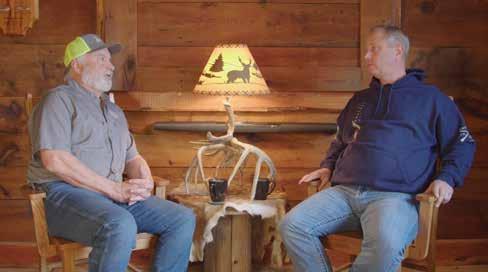
28 NYDEFA 2022
NUTRA-GLO
Nutritional Feed Supplement for all Whitetails


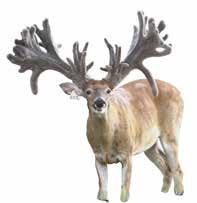



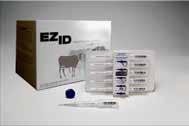
Herd Health
Digestion
Reproduction
Antler Growth
Immune System
Milk Production
Milk Quality
Stress
E. Coli Salmonella

Coccidiosis
Pneumonia
Foot Problems
CONSISTENCY
Micr ochips
• USDA 15 digit ISO
• 9 digit Avid and 10 digit Euro.
Avid Reader s

• Avid MiniTracker Livestock Reader specially priced.
• Blue Tooth® option.
• Dependable Fast, Accurate read EVERY Time!
• U.S.A. made and service.
“More Big Bucks... and Quality Does, will walk your Farm.
—If you let Nutra-Glo™ Improve your Conception Rates, Fawn Survival Rates, Feed Conversion, and Pneumonia Cases.”

-says 15 yrs of Whitetail Feedback!
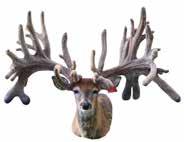
Also available for Horses, for Dairy for Dogs, for Poultry, and for Swine
Now available: Nutra-Glo for Ruminants in dry form!

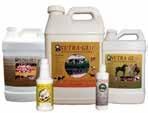
Also available in 500 & 1,000 pounds
Mention this ad And SAVE $10 on $200 or more purchase.
Coupon: event 21 Limited time offer mention this ad for discount $ave Huge on MiniTr acker Reader and Save $10 on 25 microchip SUDS
For limited time only.

29 NYDEFA 2022
Wholesale/Retail Sunrise Supply LLC 330 • 359 • 6152 Blade Star @ 6 www.nutraglo.com Custom Made @ 5 Sudden Explosion @ 3
TM
1 # 10 # 50 #
NEW YORK DEER & ELK FARMERS ASSOCIATION
1023 Route 146 Clifton Park, New York 12065
Phone: 1-518-383-2200
E-mail: nydefa@nydefa.org
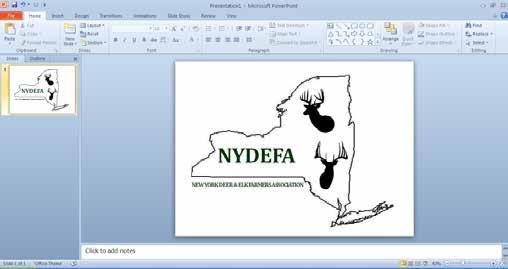
All memberships renew in March.
Please send your check, payable to NYDEFA, to the address above.
Please check the appropriate box. If one is not checked, the “Do not publish” will be used ◊Publish my information◊Do not publish
Name: __________________________________________________ Spouse/Partner:___________________________________________________
Farm/Firm:___________________________________________________________________________________________________________________
Address: ________________________________________________________________________ County:___________________________________
City: _____________________________________________________ State: _________________ Zip: ________________________________________
Business Ph.: (______) _______-___________ Home Ph.: (______) _______-___________ Fax:(______) _______-
E-mail*: ____________________________________________________ Website: _______________________________________________________ *Urgent updates are sent electronically, which allows us to expedite communication and decision making. Please provide.
Type(s) of cervid: ____
Type of Farm: Preserve/Scents/Breeding/Venison/Petting Zoo / Other: _____________________________
Veterinarian’s Name: _________________________________________________________ Phone:(______) _______-
Membership Level Cost Benefits
Active Member $50 Email notices, voting privileges, meeting minutes, and membership directory.
Friend of the Farmers $_______
Thoughtful donation.
Additional contributions are greatly appreciated.
~ Thank you for your support! ~
BENEFITS OF SUPPORTING NYDEFA
Quarterly Newsletter
E-mail updates on timely issues
Northeast Cervid Marketing Cooperative Initiative
Numerous sales, marketing and networking opportunities
NY Farm bureau support, assistance and lobbying assistance
30 NYDEFA 2022
N NYDEFA National support and assistance
S T R E N
2022 MEMBERSHIP APPLICATION

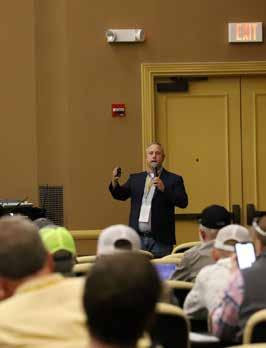
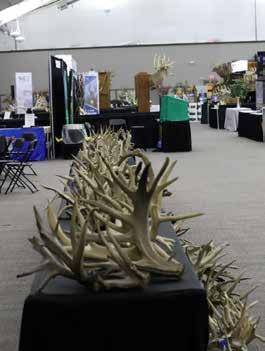
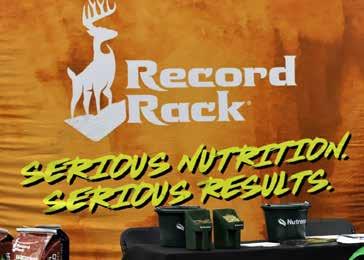


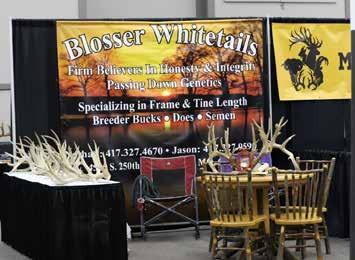
THE BENEFITS OF USING DEER TUNNELS
 By: Gail Veley • Sponsored by Whitetails of Oklahoma
By: Gail Veley • Sponsored by Whitetails of Oklahoma
Although a smaller deer farm might get by without a handling facility and tunnel system, larger deer farms can operate much more efficiently with one, explains Chris Ezell, owner of Dangerous Whitetails of Oklahoma, in Adair, Oklahoma. Deer tunnels, along with a handling facility, can allow a deer farmer to run several head of deer through in a matter of hours, greatly reducing stress on the deer while potentially negating the need to dart them.
“In my opinion, darting may hurt their immune system,” Ezell said. “If not done correctly, it could be detrimental to put them to sleep.” Yet many deer farmers depend on darts, developed by several companies through thoughtful technology intended to safely deliver antibiotics and sedatives to whitetails. While numerous farms depend on these efficient and carefully designed darts to accomplish a variety of goals including antler cutting, CIDR insertion and medication administering, for larger deer farms darts might prove

costly to buy. In addition, darting is thought by some to be best accomplished during cooler parts of the morning or evening, whereby with a tunnel system, the weather isn’t usually a huge factor, said Ivan Hochstetler of Double H Whitetails in Dundee, Ohio.
At his 23-acre farm with close to 200 typical deer, Hochstetler, like Ezell, maintains a CWD-Monitored herd. In addition to using their tunnel systems for procedures such as vaccinations, A.I. and (at Ezell’s farm) antler cutting, both men are required to test every three years for TB and brucellosis. Running them through their facilities for these purposes may take an entire day. However, in lieu of having a facility “it would take several days,” Hochstetler said. “For us, it would be a nightmare.” Yearlings, mature bucks with or without antlers and does can all be run through a handling facility. Two minutes is the maximum amount of time any deer should spend in the final phase, the squeeze chute, as additional time would be too stressful on them, Ezell emphasized. After leaving the facility, alley ways allow deer to find their way back to their pens at both farms.
When Hochstetler built his barn in 2009 with the support of his wife Ruby, he had visions of running a substantial deer empire. Even though at the time they only had two deer, the first thing Hochstetler did was put in a handling facility and tunnel system complete with solid wooden walls for added safety. Back then, the total cost was close to $10,000.
Although it would cost more today to construct the same facility, over time it would not only pay for itself, it could you save substantial time and money in the long run. “We put CIDRs in 60 does last year and then later, pulled them,” Hochstetler explained. “If our farm, as a larger operation, had to dart those does instead for the same procedure, it would have been a substantial cost. When you think about all the times you would use your facility, in two or three years that handler might be paid for.”
Ezell and his wife Jodie shared the same vision as Hochstetler when they first entered into the deer business 13 years ago and bought a farm with an existing facility. Through the years of using it, Ezell has realized the safety, comfort and ease of accomplishing whatever job that needs to be done. Although he was grateful to have bought a farm with a handling facility already in place “I would have done it anyway,” Ezell said. “When you think of all the benefits, how could you afford not to?” Consulting services for constructing handling facilities are offered by Ezell by calling him at 918-697-5389.
Deer Tunnel System and Handling Facility


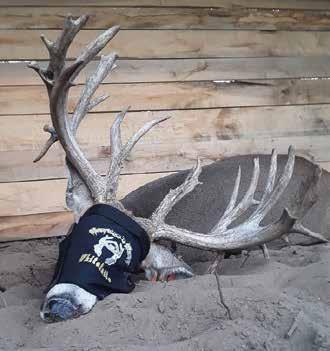

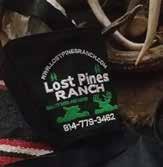
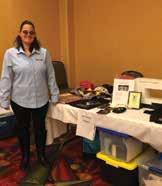
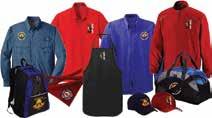
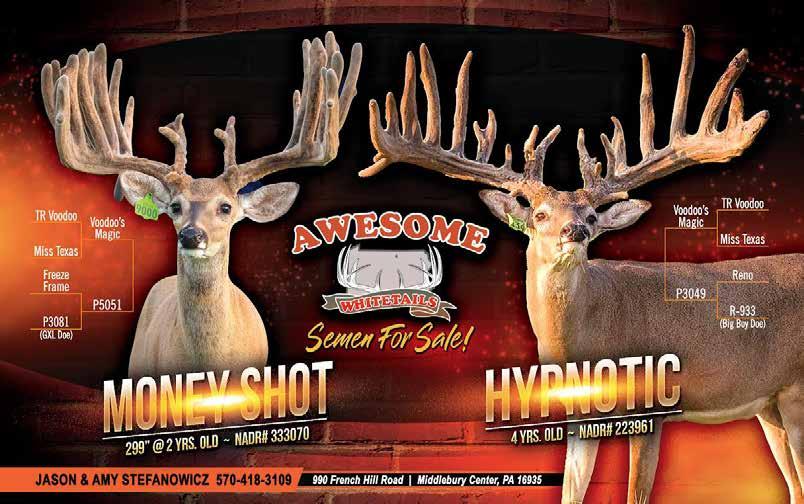
34 NYDEFA 2022 Mary Volk “The Mask Lady” 320.232.7493 cuddliez@outlook.com Deer Masks • Caps • Koozies • Apparel Custom Embroidery
CONTROLLING PARASITES IN HUMID CLIMATES

HELPFUL TIPS AND ADVICE
By: Gail Veley • Sponsored by SETDA
Maintaining an environment
non-conducive for attracting parasites while knowing how to spot and effectively treat whitetail deer presenting symptoms of parasite infestation, is the key to having the healthiest herd possible. In humid climates such as those found in Florida, Louisiana and other parts of more humid deer-raising country, parasites such as worms, flies and mosquitoes can live for longer periods of time, creating an ever-present need to be vigilant. “One of the most obvious preventative measures is to not have standing water or mud in your pens, and to keep them clean,” said Daniel Bontrager of Bontrager Whitetails in Marianna, Florida. “Rake up old hay and keep manure to a minimum and cultivate the dirt three times a year.”
At his farm, Bontrager cultivates the dirt in the spring before fawning season, in late summer to replant new grass and again in the fall to plant crops such as soybeans or peas, in an effort to keep the land viable and less inviting to parasites.
These proactive measures, combined with dry pens and “always keeping eyes on your deer” can help deer farmers stay ahead of problems, offer Susan and Ian Hall, owners of Oak Island Whitetails in Okeechobee, Florida.
They also believe that using natural water sources can help deer build up immunities to parasites.
According to internet research, there are close to 80 species of mosquitoes


and 18 species of flies that are native to Florida. “That is probably right with the actual real numbers,” said University of Florida Veterinarian Dr. Juan Campos, who works in the Department of Large Animal Clinical Sciences as well as the Department of Wildlife and Ecology. “There are 47 subspecies of the culicoides midge fly but only three that transmit EHD. Quite often we see more parasites like these year-round and farther down south in central and southern Florida where the weather is warmer.” Treating deer for parasite infestation is not always a clear-cut endeavor and Dr. Campos, 48, fears that some parasites may become resistant to traditional methods of treatment. “One of our biggest parasites, Haemonchus contortus, is getting resistant to treatment,”
Dr. Campos explained. Found in their infective stage known as Larva Three on the tips of leaves or grass after defecation from an infected animal, once ingested, the worm migrates directly to the fourth stomach or abomasum of a deer, where it attaches itself to and resides in. There, it is able to produce thousands of eggs a day. These worms feed off the blood of deer, causing anemia, weight loss, scours and an overall unhealthy appearance.
Two classes of drugs are commonly used to combat parasites, one to kill internal parasites such as fenbendazole and one to first paralyze and then kill parasites such as ivermectin. Fecal samples taken and evaluated by a veterinarian before and one week after
treatment will reveal how successful the treatment was, Dr. Campos emphasized.
He also advises to not automatically treat your whole herd, but rather only those presenting symptoms such as droopy ears or reluctance to eat, as treating healthy animals may cause them to ultimately develop resistance. “More is not always better,” he said. “We have found that most of the time only 10% of a herd might be affected by a heavy load. The others may have a few parasites, but they don’t cause them problems.” And while administering medication can prove effective in controlling or treating parasitic infections, spraying insecticides such as broad-based Permethrin inside deer pens (but not on shade cloth) is also a common preventative practice. However, “remember when you are killing bad insects you might also be killing good ones,” Dr. Campos said. “And be mindful of where you are spraying. Anything on the outer edge of where you sprayed could develop resistance.”
The Chronic Wasting Disease Research and Management Act of 2022
On Thursday, April 28, 2022, Senators John Hoeven (R-ND) and Martin Heinrich (D-NM) introduced “The Chronic Wasting Disease Research and Management Act of 2022”. This legislation is a companion to HR 5608 sponsored by Representative Ron Kind (D-WI) and G.T. Thompson (R-PA) which overwhelmingly passed the House of Representatives on December 8, 2021. At the time of introduction, the legislation was also cosponsored by Senators Corey Booker (D-NJ), Steve Daines (R-MT), Amy Klobuchar (D-MN), Cindy Hyde-Smith (R-MS), Roger Marshall (R-KS), Amy Smith (D-MN) and Jon Tester (D-MT).
This legislation authorizes $70 million annually to be split evenly between research and management practices to address CWD. NADeFA has been working closely with Members of Congress, committee staff, and a coalition of sportsman’s organizations to draft and move this legislation. This bill addresses NADeFA’s highest priority of ending this disruptive disease by authorizing funding to university and public research facilities to conduct research into ways to combat and eradicate CWD. While the legislation authorizes this funding, if passed, it would still need to be funded each year through the appropriations process.
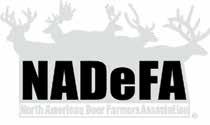
Shawn Schafer, Executive Director of NADeFA issued to the following statement on the passage of this legislation:
“On behalf of deer farmers and their families, I want to thank Senators Hoeven and Heinrich, as well as the other cosponsors for introducing this important legislation. As an industry, we have been fighting CWD each and every day and self-funding CWD research for years. Working together with our partner organizations we now have legislation in both chambers of Congress that reflects the nationwide need for research to slow and halt this disease and is a true investment in developing the scientific tools necessary to combat CWD in farmed and wild deer populations. CWD is a continuing threat to our producers and this legislation will put in motion mechanisms to change that. We look forward to working with the entire Senate to quickly move this legislation which will benefit all deer across North America. We owe it to our current and future generations of hunters, family farms, and children, to collectively pass this important legislation,”
 Shawn Schafer Executive Director
Shawn Schafer Executive Director
36 NYDEFA 2022
NADeFA Thanks Senators for Introduction of Legislation to
CWD www.nadefa.org Phone: 330.454.3944 Fax: 330.454.3950 Email: info@nadefa.org
Combat
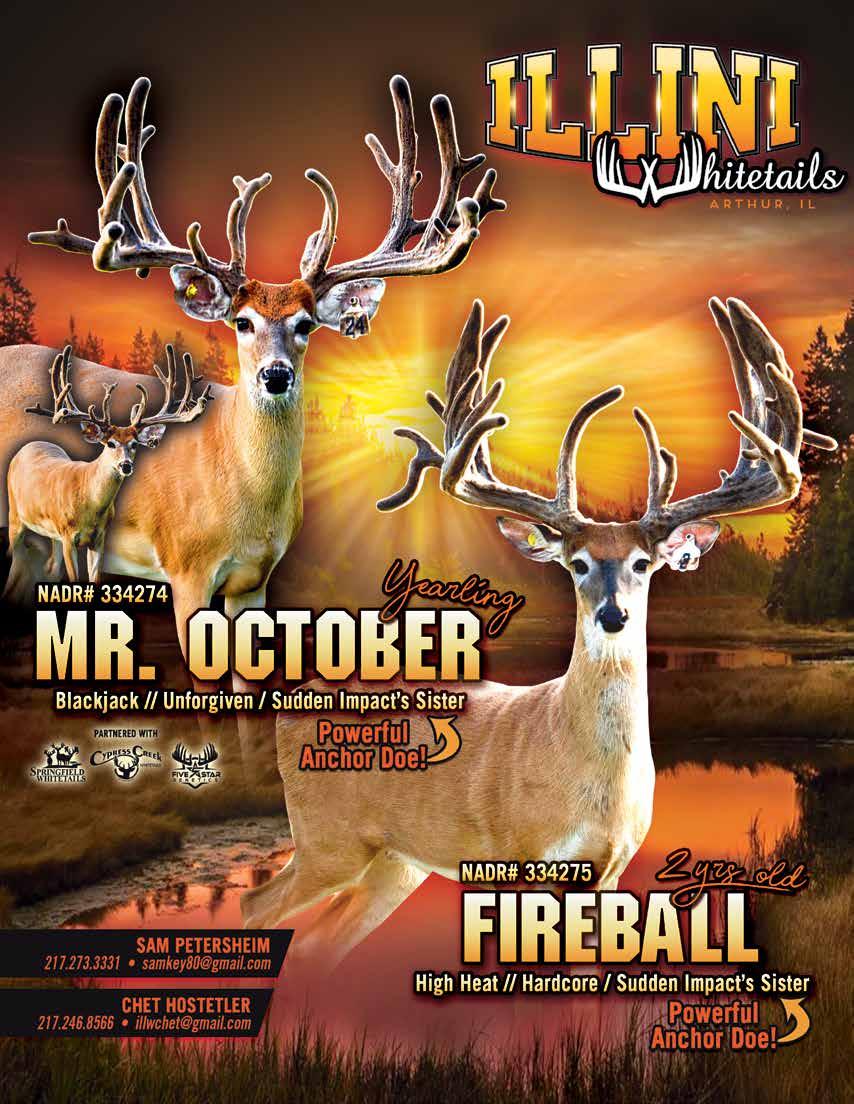
ET Crosses for 2022 at Mountainside Whitetails!
in partnership with Dana & Ella Hoover
Penn Yan NY 14527

PH: 315-595-2202
• Email: dana@ibyfax.com
ANTICIPATED 2022 ET CROSSES AT MOUNTAINSIDE WHITETAILS
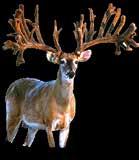


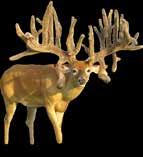
Back In Black/Major League/High Heat/Danger/Hardcore/Heather
Blackjack/Major League/Gunslinger/Maxbo XL/Heather
Blackjack/Major League/20-28/Rolex/Pink 12
Blackjack/Venom/Judge’s Prodigy/Danger/Hardcore/Heather
Cruiser/Voodoo’s Magic/Gladiator XL/Heather (Navigator’s womb sister)
Cruiser/Jumbo/Fed Ex/Texas Tea/Texas Girl (Jumbo Classic’s womb sister)
Cruiser/Voodoo’s Magic/Big Stitch/Golden Danger’s sister
Rainbow/Cruiser/Big Stitch/Golden Danger’s sister (Orange 980 womb sister)
Toxic/Blackjack/Jumbo Dream/Danger/Hardcore/Heather
AI CROSSES AT MOUNTAINSIDE WHITETAILS FOR 2022
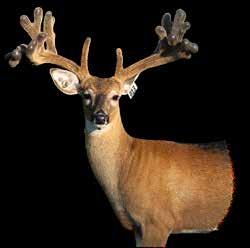
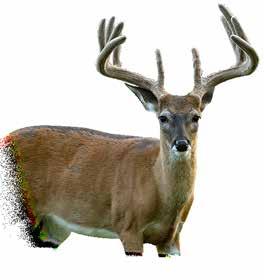
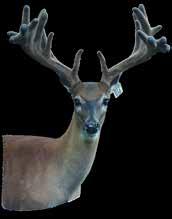
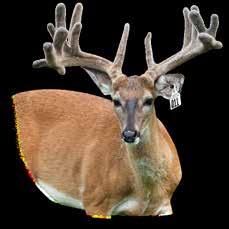
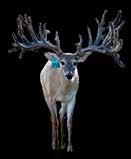
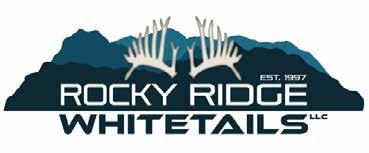
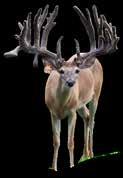
Blackjack/Major League/20-28/Rolex/Pink 12
Jasper/Gunfighter/Jumbo Dream/Danger/Hardcore/Heather
Navigator/Cruiser/Voodoo’s Magic/Big Stitch/Golden Danger’s sister (Jasper’s womb sister)
YEARLING BUCKS AT MOUNTAINSIDE WHITETAILS CONTACT
Cruiser @ 3 Rainbow @ 3 Stinger @ 1 Venom/Judge’s Prodigy
MOUNTAINSIDE WHITETAILS FOR PRICING AND AVAILABILITY
2
Toxic
Back In Black @
Rustler @ 1 Gunfighter/Jumbo Dream
@ 1 Navigator @ 2 Cobra @ 1 Venom/Judge’s Prodigy
SOLD
Blackjack @ 3 Cruise Control @ 1 Cruiser/Jumbo















































































































 By: Gail Veley • Sponsored by Whitetails of Oklahoma
By: Gail Veley • Sponsored by Whitetails of Oklahoma













 Shawn Schafer Executive Director
Shawn Schafer Executive Director













